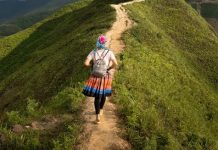Venture beyond Barcelona and its urban pleasures and you’ll find a region of forested hills, pristine beaches and medieval villages.
The dramatic peaks of the Pyrenees offer the perfect backdrop for skiing in winter and hiking in summer, and the vineyards and rustic taverns are a must for anyone interested in learning how Catalonia became one of Europe’s most celebrated regions for wine and gastronomy.
 A view over the town and vineyards of Vilafranca del Penedès
A view over the town and vineyards of Vilafranca del Penedès
Take a tour of a cava bodega
Cava, the Catalan answer to champagne, is perhaps the region’s best-known export, and the place to sample it is at the source – in one of the Modernista bodegas that dot the area known as the Penedès.
The village of Sant Sadurní d’Anoia is home to the two giants, Freixenet and Codorníu, both of which are easily reached by train from Barcelona. Freixenet has been around for a hundred years, and its tourist facilities include a little train you can ride around the vineyards, and a tasting room. The historic Codorníu bodega, meanwhile, is said to be where it all began, and is worth a visit for its spectacular Modernista building alone.
At nearby Vilafranca del Penedès is another eminent cava producer, Torres, and the town also has a wine museum, Vinseum, that makes for a diverting hour or two.
Explore the Costa Brava
The long, twisting coastline that runs up to the French border is blissfully unspoilt, thanks to the difficulty of reaching its towns by public transport. With a car, however, you can visit a series of tiny coves wrapped around golden beaches bordering crystalline water – some backed by small towns where you might find a place to linger over paella, others completely untouched.
The Camí de Ronda is a coastal path constructed for police patrols to watch out for smuggling at the end of the Civil War, and runs almost uninterruptedly for the entire length of the Costa Brava. These days it’s used as a hiking route, and even small sections of it can be incredibly rewarding – ask the tourist office for a map.
 Montserrat monastery perched high up in the mountains
Montserrat monastery perched high up in the mountains
Make for the mountains
Though known as a mountain range, Collserola – which flanks Barcelona to the northwest – is really a string of hills providing some spectacular views across the city and out to sea.
Similarly good for a morning’s hike is the small mountain of Montserrat, considered the spiritual home of Catalonia for the Benedictine monastery that perches there. Take a cable car or cog-wheel train to get up there and enjoy the panoramic views.
Skiers, however, will want to head for the Pyrenees, which usually have a good smattering of snow in winter and cater for all budgets and abilities – from the family-friendly La Molina to the royalty-friendly Baqueira Beret. Glorious mountain towns provide plenty of accommodation and eating options if the resorts or the lively Puigcerdà don’t appeal – La Seu d’Urgell is especially lovely, a mostly medieval town with a Romanesque cathedral.
 Inside the Monastery of Santa Maria de Poblet
Inside the Monastery of Santa Maria de Poblet
Follow in the footsteps of Cistercian monks
Bafflingly under-visited by tourists, the town of Montblanc is one of Catalonia’s most picturesque, a labyrinth of winding streets, ringed by 13th-century walls. An easy train ride from Barcelona, it has a smattering of traditional family-run restaurants and hotels and makes a great base to visit the three monasteries of the region: Poblet, Santa Maria de Vallbona and the Monestir de Santes Creus. Collectively known as the ‘Cistercian Route’, these three extraordinary buildings give a real sense of what the monastic life was like centuries ago.
The Reial Monestir de Santa Maria de Poblet (generally known simply as ‘Poblet’), built as a palace and religious complex in the 12th century, is quite majestic. You can still visit the 14th-century palace, the church, chapel and cloister as a part of a guided tour. Similarly stunning is the Reial Monestir de Santes Creus, with an especially evocative Gothic cloister and chapterhouse. The most modest of the three is Reial Monestir de Santa Maria de Vallbona, a still-functioning convent (with only eight nuns) and a former favourite of queens – Queen Violant of Hungary is buried here.
 A lovely whitewashed alley in the Southern town of Sitges © Westend61 / Getty Images
A lovely whitewashed alley in the Southern town of Sitges © Westend61 / Getty Images
Head south
For a sense of the variety that Catalonia has to offer, take a trip down the coast south from Barcelona. Just under an hour away is pretty, whitewashed Sitges, a sedate and upmarket place, which goes wild during carnival season thanks largely to its huge LGBTQ community. Carry on south from here and you will arrive at Tarragona, with its world-class collection of Roman remains, which include a perfectly preserved aqueduct, amphitheatre, circus and forum.
End your trip at the Ebre delta, a curious and peaceful region of rice paddies, lakes and flat paths (ideal for cycling), with an abundance of birdlife, including flamingos. Its cuisine, too, is unique – be sure to try dishes with the locally grown rice, and don’t pass up on the eel.
Wander the medieval heart of Girona
Girona deserves at least a couple of days all to itself. A splendid medieval town split into old and new (it’s all relative) by the river Onyar, its streets are considered so well preserved that it was used as a backdrop for Game of Thrones. At its heart is the lofty 14th-century cathedral, which commands a view across what was, until the pogrom of 1492, the city’s Jewish quarter. Vestiges of that time include the Banys Àrabs (actually a Jewish/Muslim bath-house) and the Museu d’Història dels Jueus, an outstanding museum devoted to the history of the Call (Jewish quarter).





